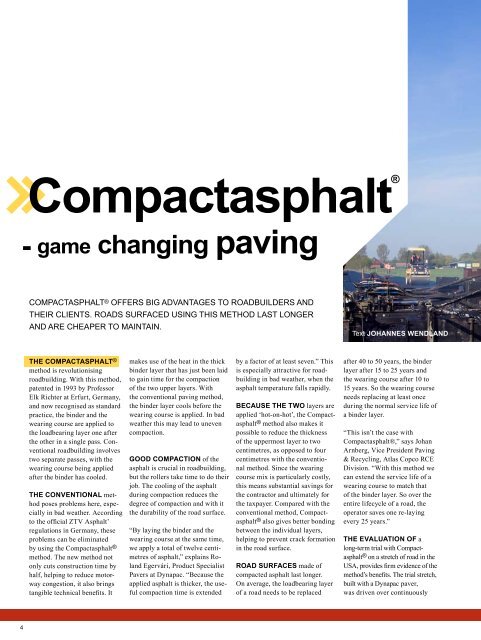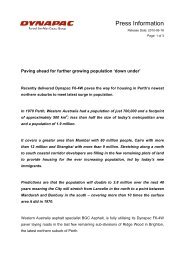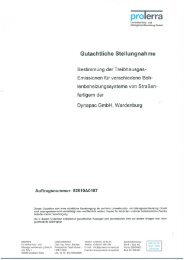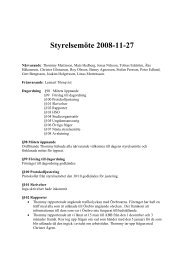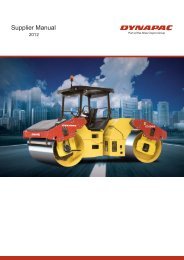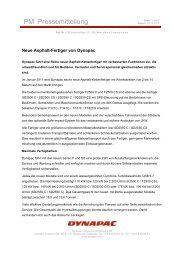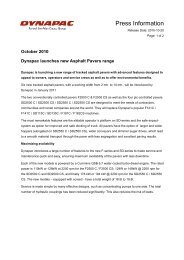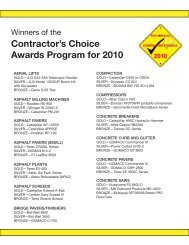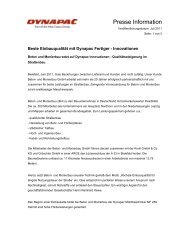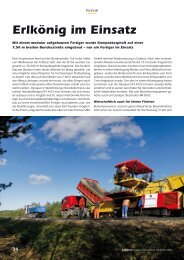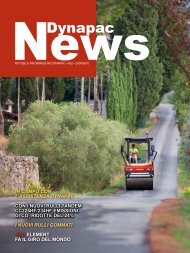Compactasphalt® - game changing paving - Dynapac
Compactasphalt® - game changing paving - Dynapac
Compactasphalt® - game changing paving - Dynapac
Create successful ePaper yourself
Turn your PDF publications into a flip-book with our unique Google optimized e-Paper software.
<strong>Compactasphalt®</strong><br />
- <strong>game</strong> <strong>changing</strong> <strong>paving</strong><br />
4<br />
CompaCtasphalt ® offers BiG aDVaNtaGes to roaDBuilDers aND<br />
their ClieNts. roaDs surfaCeD usiNG this methoD last loNGer<br />
aND are Cheaper to maiNtaiN.<br />
THE COMPACTASPHALT ®<br />
method is revolutionising<br />
roadbuilding. With this method,<br />
patented in 1993 by Professor<br />
Elk Richter at Erfurt, Germany,<br />
and now recognised as standard<br />
practice, the binder and the<br />
wearing course are applied to<br />
the loadbearing layer one after<br />
the other in a single pass. Conventional<br />
roadbuilding involves<br />
two separate passes, with the<br />
wearing course being applied<br />
after the binder has cooled.<br />
THE CONVENTIONAL method<br />
poses problems here, especially<br />
in bad weather. According<br />
to the official ZTV Asphalt’<br />
regulations in Germany, these<br />
problems can be eliminated<br />
by using the Compactasphalt ®<br />
method. The new method not<br />
only cuts construction time by<br />
half, helping to reduce motorway<br />
congestion, it also brings<br />
tangible technical benefits. It<br />
makes use of the heat in the thick<br />
binder layer that has just been laid<br />
to gain time for the compaction<br />
of the two upper layers. With<br />
the conventional <strong>paving</strong> method,<br />
the binder layer cools before the<br />
wearing course is applied. In bad<br />
weather this may lead to uneven<br />
compaction.<br />
GOOD COMPACTION of the<br />
asphalt is crucial in roadbuilding,<br />
but the rollers take time to do their<br />
job. The cooling of the asphalt<br />
during compaction reduces the<br />
degree of compaction and with it<br />
the durability of the road surface.<br />
“By laying the binder and the<br />
wearing course at the same time,<br />
we apply a total of twelve centimetres<br />
of asphalt,” explains Roland<br />
Egervári, Product Specialist<br />
Pavers at <strong>Dynapac</strong>. “Because the<br />
applied asphalt is thicker, the useful<br />
compaction time is extended<br />
by a factor of at least seven.” This<br />
is especially attractive for roadbuilding<br />
in bad weather, when the<br />
asphalt temperature falls rapidly.<br />
BECAUSE THE TWO layers are<br />
applied ‘hot-on-hot’, the Compactasphalt<br />
® method also makes it<br />
possible to reduce the thickness<br />
of the uppermost layer to two<br />
centimetres, as opposed to four<br />
centimetres with the conventional<br />
method. Since the wearing<br />
course mix is particularly costly,<br />
this means substantial savings for<br />
the contractor and ultimately for<br />
the taxpayer. Compared with the<br />
conventional method, Compactasphalt<br />
® also gives better bonding<br />
between the individual layers,<br />
helping to prevent crack formation<br />
in the road surface.<br />
ROAD SURFACES made of<br />
compacted asphalt last longer.<br />
On average, the loadbearing layer<br />
of a road needs to be replaced<br />
Text JOHANNES WENDLAND<br />
after 40 to 50 years, the binder<br />
layer after 15 to 25 years and<br />
the wearing course after 10 to<br />
15 years. So the wearing course<br />
needs replacing at least once<br />
during the normal service life of<br />
a binder layer.<br />
“This isn’t the case with<br />
<strong>Compactasphalt®</strong>,” says Johan<br />
Arnberg, Vice President Paving<br />
& Recycling, Atlas Copco RCE<br />
Division. “With this method we<br />
can extend the service life of a<br />
wearing course to match that<br />
of the binder layer. So over the<br />
entire lifecycle of a road, the<br />
operator saves one re-laying<br />
every 25 years.”<br />
THE EVALUATION OF a<br />
long-term trial with Compactasphalt<br />
® on a stretch of road in the<br />
USA, provides firm evidence of the<br />
method’s benefits. The trial stretch,<br />
built with a <strong>Dynapac</strong> paver,<br />
was driven over continuously
“With <strong>Compactasphalt®</strong> we can extend the service life<br />
of a wearing course to match that of the binder layer.”<br />
Johan Arnberg<br />
Vice President Paving & Recycling,<br />
Atlas Copco RCE Division<br />
by 60-tonne trucks, simulating an 18-year<br />
service life in just two years. The trial stretch<br />
showed not the slightest sign of fatigue in the<br />
form of tracks or cracks.<br />
“The long-term maintenance of a road is an<br />
important cost factor for the owner,” says<br />
Egervári. “A client who pays attention to<br />
quality when a road is being built, and chooses<br />
“A client who pays attention to quality and chooses<br />
<strong>Compactasphalt®</strong> can look forward to decades of<br />
trouble-free service.”<br />
Roland Egervári<br />
Product Specialist Pavers<br />
Compactasphalt ®, can look forward to decades<br />
of trouble-free service.”<br />
BY THE END of 2007, <strong>Dynapac</strong> machines had<br />
laid five million square metres of compacted<br />
asphalt in Germany, China, Poland and Russia.<br />
In Germany, the company has supplied<br />
three large type F 300 CS road pavers for<br />
Compactasphalt ®. This year, <strong>Dynapac</strong> will<br />
the f300Cs / am300 moDular<br />
paVer CaN Be useD Both for the<br />
CompaCtasphalt ® methoD aND<br />
CoNVeNtioNal paViNG.<br />
rolaND eGerVÁri<br />
be launching a modular extension of the triedand-tested<br />
DF 145 CS paver. This will enable<br />
smaller construction firms to switch to <strong>paving</strong><br />
with Compactasphalt ® at a favourable cost.<br />
They only need to keep one paver, which can be<br />
quickly adapted as the need arises. This brings<br />
huge cost benefits, which firms can pass on to<br />
their clients – giving them a further argument in<br />
favour of Compactasphalt ®.<br />
5
6<br />
many advantages<br />
with the<br />
Compactasphalt ®<br />
moDular DesiGN – taNGiBle BeNefits eNViroNmeNtal BeNefits<br />
FOR ROADBUILDING using the Compactasphalt ® method,<br />
<strong>Dynapac</strong> offers the f300Cs high-performance paver. this<br />
machine has two hopper modules to hold the materials for the<br />
binder layer and the wearing course, and two screeds – a highdensity<br />
screed for the binder layer and a normal screed for the<br />
wearing course. The two screeds are adjusted relative to each<br />
other to ensure that the thickness of the two layers is constant.<br />
The maximum working width of the finisher is 13.25 metres.<br />
DYNAPAC IS CURRENTLY working on a modular extension of the<br />
Df 145 Cs series paver for working widths of 2.55 to 7.50 metres.<br />
so it will soon be possible to deploy this widely used paver for both<br />
the standard method and Compactasphalt ®, allowing contractors to<br />
exploit their machines far more efficiently.<br />
THE OPPORTUNITY to reduce the mix temperatures and<br />
therefore reduce pollutant emissions.<br />
BY REDUCING the mixed good temperature at 10 °C,<br />
approx.0,23 l heating oil per one ton can be saved.<br />
LONGER DURABILITY of the wearing course saves energy<br />
costs concerning the production of mixed good.<br />
REDUCED ROAD REPAIR and maintenance works.<br />
NO BITUMEN EMULSION is needed (which is sprayed on the<br />
binder layer in case of the conventional laying method)<br />
AN ADDITIONAL REDUCTION of the asphalt binder course<br />
from 10 cm to 8 cm (highway projects) is possible.<br />
arNe eiChstaeDt<br />
method<br />
“We’re convinced of the<br />
quality and also see the<br />
clear cost and time<br />
benefits of the method.”<br />
Arne Eichstaedt<br />
Head of Bunte Braunschweig
IMPROVED LAYING qUALITY<br />
& HIGHER DURABILITY BY:<br />
Creating a thicker asphalt layer during<br />
laying and therefore an obviously significant<br />
extension of the period of time available<br />
for final compaction (t=k*d1,8) [1]<br />
and the possibility to optimise the degree<br />
of compaction, and positively influence<br />
the deformation resistance.<br />
t= time, k= constant, d= layer thickness<br />
the available time for compaction<br />
increases with the power of 1,8 of the<br />
actual layer thickness. By increasing<br />
the layer thickness from 4 cm to 12 cm,<br />
the available time for compaction is<br />
increased 7 times!<br />
REDUCING THE INFLUENCE OF BAD<br />
WEATHER on the compaction properties<br />
of thin wearing courses by using the<br />
asphalt binder’s residual heat.<br />
JOHANN BUNTE Bauunternehmung<br />
Gmbh & Co. kG is<br />
a leading German construction<br />
company based in papenburg.<br />
since 2004, the company has<br />
used the <strong>Compactasphalt®</strong><br />
method on numerous roadbuilding,<br />
<strong>paving</strong> a total of 1.5<br />
million square metres. the<br />
company has a <strong>Dynapac</strong> f 300<br />
Cs / am 300 modular paver<br />
HIGH AND HOMOGENOUS DENSITY<br />
through the complete layer depth<br />
(wearing course and binder course)<br />
EXCELLENT INTERLOCKING OF THE<br />
COURSES (Cut power 37kN) Due to its<br />
optimum bonding it will better withstand<br />
high vertical forces. this is main criteria<br />
for the long service life of the asphalt<br />
pavement.<br />
REDUCING THE APPEARANCE OF<br />
RUTS AND CRACKS as it is possible to<br />
take up higher vertical and horizontal forces<br />
due to optimum degrees of compaction<br />
and high layer adhesion (bonding<br />
and tight interlocking).<br />
BETTER DURABILITY can be expected<br />
due to a feasible high deformation resis-<br />
and also deploys the machine<br />
on projects using the conventional<br />
method. “for large construction<br />
projects, Compactasphalt<br />
® is the method of the<br />
future,” says arne eichstaedt,<br />
head of Bunte’s Braunschweig<br />
office. “We’re convinced of the<br />
quality and also see the clear<br />
cost and time benefits of the<br />
method.”<br />
tance and good interlocking of the layer,<br />
together with optimum air void content.<br />
IT IS POSSIBLE TO EXTEND THE<br />
PLANNED LIFETIME of the top layer,<br />
to be close to the lifetime of the binder<br />
course.<br />
ECONOMIC OPTIMISATION of the<br />
wearing course’s surface properties with<br />
regard to skid resistance, brightness and<br />
also the reduction of the course thickness.<br />
COST REDUCTION<br />
Due to a 50 % thickness reduction of the<br />
expensive wearing course. No bitumen<br />
emulsion is needed between the binder<br />
and wearing course. Significant reduction<br />
of <strong>paving</strong> times due to the simultaneous<br />
laying of both courses.<br />
“The<br />
method of<br />
the future”<br />
7


